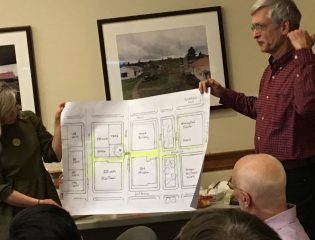
(Photo: J Maus/BikePortland)
Two influential City of Portland advisory committees oppose plans by the Portland Art Museum to create a new structure that would limit public access on a downtown block.
As we reported on March 29th, the Portland Art Museum’s $50 million Rothko Pavilion plans would further restrict public right-of-way between Southwest Park and 10th Avenues. On March 14th, at a joint meeting of the Portland Bicycle Advisory Committee and the Portland Pedestrian Advisory Committee, members overwhelmingly opposed the plans in an informal straw poll. Before taking an official position on the matter, the chair of the bicycle committee invited a representative from the museum to a subsequent meeting.
“PBOT really stresses the need for connectivity. We’re really struggling with this issue.”
— Christine Leon, PBOT Development Permitting and Transit Group Manager
On Tuesday Portland Art Museum Chief Advancement Officer JS May made his case. After introducing himself as a bicycle rider and former board member of The Street Trust (formerly the Bicycle Transportation Alliance) and current board president Cycle Oregon, May told the committee, “I rode through Madison plaza on my way over here tonight. I’m one of the people this is going to inconvenience.” But May added that he’s not going to be around in 125 years and this project is about something larger. “What does the city want in terms of its vision? People can look at this as a pedestrian issue or a bicycling issue or an arts access issue — what we’re trying to do is balance those three things.”
For the museum, the goal is to “Create one of Portland’s grand public spaces.” But the crux of this issue revolves around whether or not the public will have adequate access to that space — and how that space will limit connectivity, a bedrock of good urban planning.
According to the official city ordinance up for adoption at City Council this Thursday (4/20), the Rothko Pavilion would restrict public access through the block for an additional four to eight hours per day. It would also completely prohibit bicycling. The museum currently operates with an easement on that block first granted in 1968. That easement required an eight-foot minimum path for the public 24 hours a day. In 1984 the museum requested — and was granted — permission to close the plaza at night due to security and vandalism concerns. Museum officials now want to build a new structure and limit public access to only museum hours.
The letter jointly signed by the chairs and vice-chairs of both advisory committees, lists the following concerns:
● The amendment diminishes the usefulness and network connectivity for people who walk and bike along SW Madison utilizing the vacation between SW 11th Avenue and SW 10th Avenue adjacent to the YMCA.
● The presence of small, walkable (and publicly-accessible) blocks are critical to a pedestrian-oriented city, especially downtown where the standard block size is 200×200 feet.
● The proposed creation of a superblock, even with the described access, fails to live up to the city’s adopted goals of a walkable city.
● Public access to this block has been incrementally eroded over the years, and the proposal is an unacceptable further limitation of public access.
● The renderings and proposed language regarding the new Rothko Pavilion creates the appearance of a private building entrance blocking a vacated street, which will create the perception that only paying Museum customers will be able to use this connection, and that all other individuals not using the Museum should walk around the building.
● Allowing this exception to the city’s street vacation policy will set precedent and prompt future requests that would further compromise Portland’s renowned pedestrian and bicycle network.
Advertisement
PBOT is feeling pressure from both sides. “PBOT really stresses the need for connectivity,” said the city’s Development Permitting and Transit Group Manager Christine Leon at the Bike Advisory Committee meeting on Tuesday. “We’re really struggling with this issue.”
Bicycle Advisory Committee member Elliot Akwai-Scott shared similarly conflicted feelings: “We all support what the museum is trying to accomplish; but not the way they’re trying to achieve it.”
“We all support what the museum is trying to accomplish; but not the way they’re trying to achieve it.”
— Elliot Akwai-Scott, Bicycle Advisory Committee member
While the museum won’t charge a fee to use the new pavilion or travel through it, there are worries that most people will see a building structure and will assume it’s only for paying museum customers. Other committee members expressed worries that granting this easement would set a dangerous precedent for other central city developers who’d want to limit public access — resulting in less connectivity and eroding Portland’s efforts to encourage biking and walking.
PBOT Project Manager Caitlin Reff said they get many requests to close public access through private property and the city’s current stance is to “maintain connectivity standards at the highest threshold we can deliver.”
The ordinance language released Friday states that the easement must be “unobstructed” and “include clear wayfinding with no visual obstruction.” It’s unclear if the city would allow an enclosed pavilion like the museum has proposed (we’ve asked PBOT for clarification but have not heard back). (UPDATE: The ordinance doesn’t require an open plaza, just that the structure be clear and transparent.)
Rithy Khut, chair of the Bicycle Advisory Committee, wants the museum to find a different solution. “There’s a possiblity that the design team could design a building that the public could pass through, isn’t that correct?” he asked May. “We’ve looked at that,” May replied. “One of the design goals is to make this ground floor a community commons, a place full of art… It’s very hard to also make that be a pass-through that would be open all times of day.”
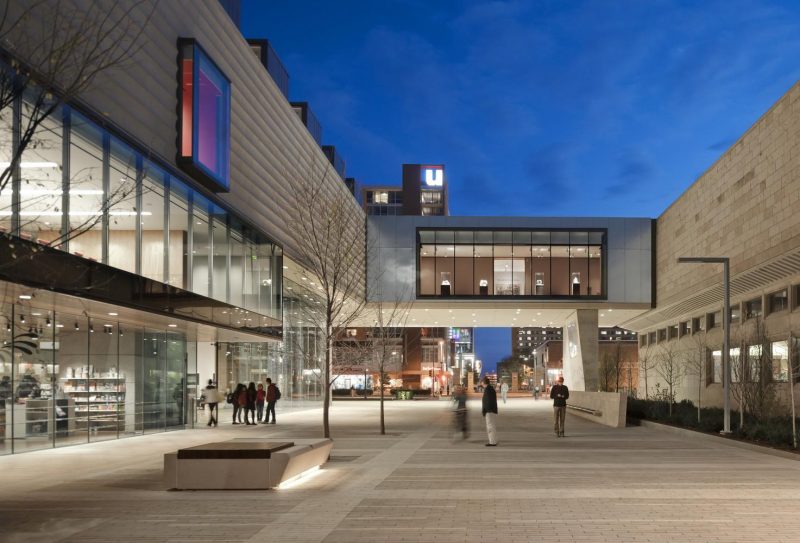
Noted walking advocate Doug Klotz spoke up in opposition to the museum’s plans. He brought a diagram with current access routes highlighted and told the committee, “If it has doors, it won’t work. It has to be open. I’m not in favor of putting any structure there.”
Khut and other advocates agree with Klotz and think an elevated structure that leaves the ground floor open is the answer. They point the Chazen Museum in Madison Wisconsin, the Hirshhorn Museum in Washington D.C. and the Rijksmuseum in Amsterdam as examples of museum expansions that maintained through access for the public. May shot down the Amsterdam example, citing its $500 million price tag. “It’s a different world,” he said, about a country with more money and more taxes to spend on projects.
But it appears the biking and walking committees aren’t taking no for an answer. Here’s an excerpt from their letter:
“We believe that PAM and their architects have a unique opportunity to meet the policy goal of Policy 9.46 within the proposed Central City Plan for 2035 [which states that projects should, “Differentiate the character of key streets to offer a diversity of urban experiences and connections, reflect the character of unique districts and expand open space and recreation functions in the right-of-way where possible.”]… By maintaining unfettered access throughout the day, no other location in the Central City can provide this experience where the Right-of-Way can be directly intertwined with the cultural and artistic urban experiences. We are confident that the excellent design team at Vinci Hamp Architects can design a Rothko Pavilion that will allow continuous access… we feel confident that Vinci Hamp Architects can design a building that meets both the requirements of continuous access while connecting both museum spaces, ultimately creating a space that meets the goals of the Portland Art Museum, the City of Portland Transportation System Plan, the Central City Plan for 2035, and most importantly, people who walk and bike along SW Madison Avenue.”
Bicycle Advisory Committee member Dan Bower (executive director of Portland Streetcar Inc), agrees. “I think we should push this as a design challenge to the museum… they can solve it.”
The new easement is up for a vote at City Council this Thursday at 2:00 pm.
UPDATE, 4/18 at 8:00 am: The City of Portland Planning and Sustainability Commission has requested a delay in the City Council vote on this issue. The request was made in a letter to Mayor Ted Wheeler and City Council from PSC Chair Katherine Schultz dated April 14th. “The PSC would like to emphasize to City Council that public access across this location is very important,” it reads. “The design of whatever replaces the current open connection is critical for this connection to be successfully replaced. We should not start the design of a replacement with the assumption that reducing the connection from full access to pedestrian-only is acceptable other than as a last resort.” The PSC will host a hearing with public comment opportunity at their meeting on April 25th.
— Jonathan Maus: (503) 706-8804, @jonathan_maus on Twitter and jonathan@bikeportland.org
BikePortland is supported by the community (that means you!). Please become a subscriber or make a donation today.





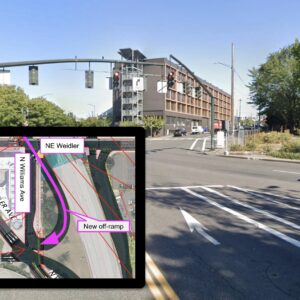
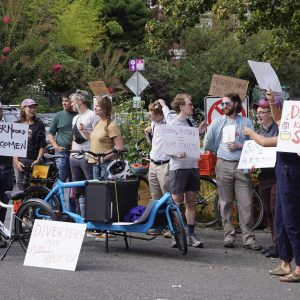
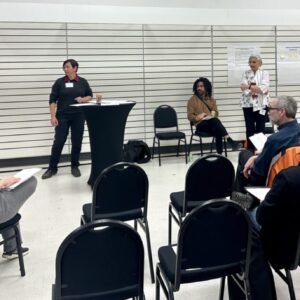
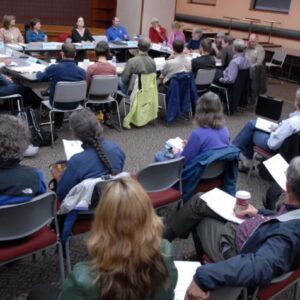
Thanks for reading.
BikePortland has served this community with independent community journalism since 2005. We rely on subscriptions from readers like you to survive. Your financial support is vital in keeping this valuable resource alive and well.
Please subscribe today to strengthen and expand our work.
No thanks. This is about the obesity epidemic. Businesses didn’t remove the Ankeny Alley to make artwork. They created a community.
How exactly is this about the obesity epidemic?
The proposed building would also block corridor views from the Park Blocks of one of the city’s oldest and largest elm trees on the west side of SW 10th Avenue.
Limiting access to museum hours means completely closed on Mondays, open 10-5 most of the rest of the days. (10-8 Thursday and Friday.) Loss of summer evenings, and loss of a quieter route when walking to and from work when the streets are noisiest with cars. No.
That seems like something that could be negotiated
Perhaps a doorbell you could ring to be let through after hours?
Yes, because the art museum will be totally cool with people camping there overnight.
And the next time PAM loses some funding and decides to reduce their hours?
Good point. Before this, the museum can threaten reduced access to the museum if people don’t give it more money. Now, it can threaten reducing the hours the public can use its own street.
I hope Council sends this back to PAM for a design that keeps access as it is.
IDK, I’m a fan. These arguments just sound like whataboutism… anybody else wanna make a more pragmatic argument besides “This won’t work for me.”?
They are proposing to block a public right of way. What other option is there? I mean, if you are looking for specifics, I don’t know: a design that builds over the space while leaving it open for pedestrians and cyclists? The Rijksmuseum in Amsterdam is a good example:
http://www.amsterdamtravelguide.com/discover-amsterdam/museums/art-museums/rijksmuseum-amsterdam/#
“This won’t work for me” is a perfectly good argument. Nobody in fact should be needing to provide ANY reason why the museum’s plan doesn’t work for them.
The burden should be on the museum to explain why it can’t possibly come up with an expansion design that doesn’t interrupt the same street grid that works so well for half a million people. That includes explaining why none of the many solutions other museums have done successfully elsewhere can’t possibly work here.
half a million people walk through there a day?
No, half a million people live in Portland, and use the street grid, and manage well without asking to privatize streets for themselves.
How did $500 million get thrown out as anything close to a likely cost for construction of an expansion that would be over an open pedestrian area? Just to compare, the Tillicum Crossing Bridge cost about $135 million to build, and the new Sellwood Bridge project cost about $325 million.
With the caveat that I’ve followed this at all until last week, it appears that PAM already thinks of this as effectively their privately held land, sees all this as a bit of a formality, and therefore is not seriously exploring options that prioritize public use.
It’s unfortunate that an organization that benefits so much from public space (being on the Park Blocks and all that means in terms of ambiance and prestige) isn’t a bigger advocate of holding public space as sacred.
Yeah, I’m a bit offended that they announced it on their website like it’s a done deal. http://portlandartmuseum.org/museum-expands-rothko-pavilion/
Wow–arrogant. The Japanese Garden did the same thing about a year ago, when it announced that a solution had been arrived at in regard to the public trail that its expansion removed. The announcement came before the Parks Bureau had even shown the “solution” to the public.
At least here, it sounds like the City is acting far more responsibly than Parks did in that woeful case.
“It’s unfortunate that an organization that benefits so much from public space (being on the Park Blocks and all that means in terms of ambiance and prestige) isn’t a bigger advocate of holding public space as sacred.”
Good point. Thinking of it that way, the museum is acting like the developers who get attracted to a neighborhood like Sellwood, with its homes that contribute so much to the street, then build rowhouses that create a streetscape of curb cuts and garage doors, benefitting from the character while diluting it themselves.
I also get the feeling the museum will market (or already is marketing) this idea as a chance for the public to come into their institution and get a taste of what’s inside for free. Yet in decades, they’ve never done anything like that, even though they’ve had the opportunity. If they could, they’d privatize the street 100%, and based on past behavior, it this gets approved, they’ll push the City to allow them to whittle away at hours until it is private.
I am excited about the Museum expansion and, I admit, I was annoyed that people were complaining about the loss of a walk the dead-ends a couple block to the west anyway. However, after reading this and giving it a bit of consideration, I have changed my mine. Even though the PAM is quasi-public, this new space would not be public in the sense it is now. I must agree that that is an unfortunate erosion of public space and probably a missed opportunity for the PAM to create something really unique that preserves public access, offers a free glimpse into the museum, and still meets the exhibition space required. When I lived in BC, I loved visiting Stanley Park. They have an aquarium within the park that is pretty much fenced/screened off from view. However, they intentionally added a couple of spaces where you could get a free glimpse into the park and see a bit of the porpoise exhibit and I think the Beluga. I loved strolling by and having my peek. As a result, the Aquarium was much more on my mind and I ended up visiting more frequently and taking guests, etc.
Good. For once lets have areas where pedestrians can feel safe. Even if it’s from bicycles.
Damn scorchers!
Do yo need a safe space?
This is the best news I’ve had all day.
I live in the Eliot. At our annual owners meeting in December, this came up and the opposition was probably at least 10:1. (There were well over 100 people in attendance and only 1 couple spoke in favor of it.) By a show of hands, it appeared that 90% of the attendees at that meeting were also Museum members. I expect many of my neighbors to attend the 4/20 meeting to speak against the project.
I support the Museum, generally, but this project is arrogant and selfish. It plays to the stereotype that the Fine Arts community is elitist, aloof, and out of touch.
it is too bad their design committee/ project manger did not attempt to reach out earlier to the affected groups to work through these design issues vs just saying at this late date “its too late” / “already looked into it” etc…
As for ped access…if they show that all these design options have been fairly looked into then what would be the fair mitigation to the public/ aka land owner (the “non-paying”visitor)? Would it be a door bell that a valet / security guard has to open when prompted (within x seconds)?
…As for cyclists, will their mitigation plan improve the detour route vs. just putting up a sign “No dogs or cyclists allowed!”?
If this gets approved, there will be no stopping the other requests to close plazas/easements.
Fear based
OK, so no bikes and no dogs. Will sports jackets be required to pass through? Do runners have to walk through? Put on shirts? Will backpacks have to be checked when you go in, and retrieved when you go out the other door? Will talking on the phone be allowed? Babies? Can you carry your slice of pizza through? Carry it but not eat it? Can you loiter?
The museum representative May states, “People can look at this as a pedestrian issue or a bicycling issue or an arts access issue — what we’re trying to do is balance those three things.”
That’s the problem. Within the street space, arts access isn’t an equal to pedestrian or bicycle travel.
If the museum wants arts access to have equal footing to those other uses within the street space, then pedestrians and cyclists should demand that the museum balance pedestrian and bicycle access with arts access within the museum’s galleries, using the museum’s own argument that since all are important, all should be “balanced” regardless of where they’re occurring.
i bet you a million dollars more people walk through here after this is completed.
I bet you two million that more people will want to spend the night once they get inside.
You could be right, Slammy, but so what? It’s a public street, and its purpose is to allow travel from one side of the block to the other. If it’s turned into a museum lobby, certainly some people will come for the experience of walking through it. It’s a guess whether those people would outnumber all the people who can’t bike through any more, and who can’t walk through outside museum hours. But those are the people the street is supposed to be serving. People who want the museum experience can always go to the museum.
The museum could hand out free ham sandwiches to everyone who walks through the lobby, and guarantee even more traffic, but again, so what?
its not a street
Each time I take a look at the rendering of the new pavillion, I like it less than before. With all due credit to the design team, in addition to blocking off public access to an important, walk-able public street, it’s not inspired architecture. Its facade is essentially just a glass wall, ok for a shopping mall, but not for a museum.
One of the things that seems very appealing about the University of Wisconsin, Chazen Museum of Art, pass through as seen in the pic included in this story, is how high the spotlit ceiling is above ground level, and correspondingly, the heads of people underneath. The walk through experience looks to be one of spaciousness. It looks airy and inviting, instead of claustrophobic and restrictive.
It should be noted too, that because of its north-south orientation, and even with its comparatively low height, the pavilion will further block late afternoon and early evening skylight from passing down Madison and into the park. Is this ‘no big deal’ to most people? Maybe. People in cities, are resigned to or get used to the concrete canyon effect. The block immediately north of the museum’s annex(former masonic temple.), eventually may be built upon, blocking the sunset from reaching the park block with Shemanski Fountain to the east. That’s city life. With luck though, Main street will be kept free and open to people on foot, bikes and to the sky.
Also remember that renderings can lie. The addition wouldn’t be nearly as transparent in most conditions as the rendering shows. Even in the perfectly even daylight shown, the glare on the glass would increase as your view went up the wall.
And that’s assuming it will be built exactly as shown. Add some coated (I don’t mean totally reflective) glass to protect artwork, some banners on the glass, some interior displays that block views, and most of the transparency will disappear.
In other words, the transparency is fragile, depending on just the right materials, and just the right lighting conditions. In contrast, the Chazen design is a big, tall, open space. There’s not much that could be done to make it less so, other than perhaps turning off some lights.
The museum’s rendering needs to be viewed for what it is–a promotional tool to sell the addition idea to the City.
Here’s a recent example of an institution that misled with a rendering. The Japanese Garden, in its expansion’s publicity and land use review application, showed a rendering of a cluster of small buildings, arranged stepping up to follow the site’s topography, connected by narrow, naturalistic pathways meandering through a central landscaped space:
http://www.nextportland.com/wp-content/uploads/2015/03/japanese_garden_2010.jpg
Once the land use review was approved, this rendering appeared, which realistically showed what was built–larger buildings arranged around a large, dead flat, 99% paved courtyard: http://assets.inhabitat.com/wp-content/blogs.dir/1/files/2015/08/Portland-Japanese-Garden-expansion-by-Kengo-Kuma-2.jpg
The Japanese Garden was still using the initial rendering even when it knew the design would be like the later rendering, which was dishonest. But when it prepared the initial one, it most likely believed that was what the built result would look like. That’s the thing, though–designs change.
The point isn’t to say whether the Japanese Garden built something better or worse than the original rendering, it’s to show that the final design looks much different than the initial rendering. So nobody should assume that what the museum is showing now accurately shows what would be built.
so you are unhappy with the end desgn of the japanese garden as well?
Yes. I admire the architecture. The path is a compromised design. But my own opinion is beside the point.
“…there are worries that most people will see a building structure and will assume it’s only for paying museum customers.
Other committee members expressed worries that granting this easement would set a dangerous precedent…”
Both points spot on. This is public owned space, as in the street, and the City has a clear obligation to keep it open-air for the public good.
Equitable access should not be just physically possible, but emotionally inviting.
I want to keep it public. Have used that cut-through many times. But I think PAM’s responding to the “we can’t have nice things anymore” thing Portland’s been forced to grapple with throughout the city. A significant few destructive types are having a big impact on decisions like this (or, for example, the 40-Mile Loop veto, or postponement). I’m not mad at PAM, or the folks in Gresham and Troutdale.
why do you need a cut through?
It’s not a “cut through” unless every public sidewalk, street, or path is a “cut through”.
The “we can’t have nice things anymore” is the argument I’d expect to hear from the museum in a couple years after opening if this got approved: “We created this wonderful opportunity, at great expense to the museum, for the public to enter into our institution and be elevated by Art. Unfortunately, due to unforeseen security (or “cost” or “safety” or…) reasons we must restrict access…”
If someone wanted to design a street connection that would guarantee conflicts between the museum and the public, it would be hard to top one that requires the public to enter the museum and walk through the lobby to get from one side of the block to the other. Think of how many things that could go wrong, and trigger the “we can’t have nice things” argument.
Sure. I’m just saying that–based on my experience living right there for a year and a half, recently–there were problems with vandalism, harassment and lots of littering in that courtyard. I’ve been expecting them to remove the sculptures out front and in the courtyard for some time now. The Park Blocks in general had become a de facto camp/dump up there.
Yes, I agree. The City has some responsibility to protect the museum from those activities. I’m sure the current context influenced the museum’s close-it-all-in design.
It’s a public right of way. Keep it that way.
Seems to me it shouldn’t be that hard to tweak the design to keep the ground floor open with a well-lit 24/7 passage through. I don’t think it will matter much if bikes are barred; easy enough to go around. But pedestrian access should be kept open and not blocked by doors, or limited by museum hours.
the example given at the meeting about “tweaking” the design …looks like an old rendering of lloyds center shopping mall
Most of the people who are writing these comments probably just sit at home complaining about things they don’t even take advantage of….the Museum or public access…
What about yourself? Do you do much walking downtown, around the museum or elsewhere? Do you go to the museum much?
Lots of people walk downtown, in and near the South Park Blocks and near the museum, and also using Madison past the museum. I’ve always greatly enjoyed this block of Madison going back to the day when on its west end, there was a sunken plaza with a big fountain adjacent to the art school classrooms on the basement level.
The more recent design isn’t bad in all respects, but it got rid of the sunken plaza and fountain (the fountain water outlets were never quite well conceived…too much water, too loud.), and for the new museum store cafe terrace, it incorporated a lengthy, tall glass, semi-opaque frosted design wall paralleling part of the Madison easement, which has significantly obscured the museum from people walking on this part of the street.
From the first time I experienced walking past that walled off section of the museum, I felt that this was bad design for the museum, which should be wanting to include people rather than exclude them. The current design proposal goes further down that track. People apparently will still be able to freely, without payment, walk Madison through the pavilion during certain hours, but it’s difficult to avoid feeling the exclusivity that, by way of the easement the city has graciously granted to the museum, this institution is bringing to bear on this street.
In terms of design on the Madison easement, the museum has done some great though temporary things in past. I’m thinking of those suspended and soaring canopies from some years back. They were big, airy, and provided an interesting shape in contrast to the museum buildings themselves, which are all horizontal lines, and rather conservative in design…that’s ok to some extent…the museum structure shouldn’t overwhelm the art, but ‘too much of a good thing’ can happen if people aren’t pushing themselves to think outside the box.
i dont have a car …I walk everywhere …..I live on the south park blocks. you walked by the wall …. you felt walled off…yoiu felt it was a bad design….its all very subjective….you people dont run the museum ….did they say …”Lets do this to spite people who dont like change….who this we are elitist” have you asked why the museum wants to do this or n eeds to do this instead of feeling personally threaterned? lets all focus on something more objective and will benefit everyone like getting Trump out of the white ASAP!!! the reason theres opposition is because we are conditioned to have that space there to walk through…. choose another way…. take a diffrent route…. be adventurous … take Uber to the othersi]de of the museum if youre unable to walk around….
You’ve got it all backwards. A private organization wants to take over public space. It’s not the public’s responsibility to accept that and work around it. You should be asking the museum to figure out another way to expand that doesn’t shut the public out of a public space, not telling everyone else to accommodate the museum’s takeover.
Access or just an easy way to get to the next block with out exerting yourself? Simantics or entitlement? dont see throngs of bikes or pedestrians going through this public breeze way. Ive lived on the south park blocks for 7 years now. Walk around or bike around its not 100 miles. The design at least maintains visual access allowing as much light and a view of trees etc.
How wonderful that the museum is offering the public visual access through the private building that the museum proposes to build on top of the street that the public owns!
Perhaps when it’s pouring rain, and I find that I’ve got to the lobby door two minutes after closing, forcing me to walk around the block because I can’t use the street, I’ll catch a glimpse of a wonderful Neo-Postmodernist painting within the lobby, which will momentarily uplift my spirits and make me not mind missing my bus.
Better yet, a private after-hours event will be starting up, and while I’m not able to be let in the door as are the paying patrons, seeing them–perhaps literally rubbing shoulders with them–being ushered in past me will inspire me, giving me a glimpse of a life of culture and refinement I may not yet–or perhaps never–will share with the patrons in all their finery, and I’ll be swept if only briefly into a world where the realities of my dreary existence will be forgotten. No longer will I view this as a lowly street closure, but as an ASPIRATIONAL REALLOCATION of public space.
we dont “own” anything….we are all passing through this life ….theres your shorcut right there….death
“Noted walking advocate Doug Klotz” Im confused. If you are a “walking advocate” walking aroung the museum shouldnt be the issue. If you are a “noted” short cut advocate then I see your concern.
You have it backwards. If you block a street by putting a building in it, the people walking through are not taking a shortcut. They are using the street that you are blocking.
q its not a street by definition….it wasnt a street before, its not a street now and it will never be a street. cars don’t go on side walks and people dont walk dowqn streets≥ that would be a world of chaos and anarchy….
First, “street” by definition doesn’t require that motor vehicles use it, so you’re wrong on that. It may be too obvious to point out, but one clue that that’s true is the fact that there weren’t motor vehicles until just over a century ago, but there’ve been streets for thousands of years.
Second, per an earlier bikeportland article, it was a conventional street until 1968, when the City allowed it to be redeveloped as a plaza which was required to allow pedestrian and bike access. Now the museum wants to renegotiate that deal, and be given permission to build museum space within the former street space. For the PRIVILEGE of being granted permission to build there, it’s reasonable for the City to ask for something (keeping the ground floor open for bike and pedestrian use) in return. Nobody’s asking for it to be reopened for motor vehicles.
Besides also being wrong about it not being a street before, you’re also wrong that “people dont (sic) walk dowqn (sic) streets”. There are streets all over the world where that happens legally and intentionally, sometimes where pedestrians mix with vehicles, other times where the street doesn’t allow vehicles.
Portland’s NE 6th place is a street that was created specifically to allow pedestrians and vehicles to mix. SW Miles Place was just redeveloped to continue to allow pedestrians and bicycles to mix with vehicles. The street is also the Willamette Greenway Trail. There is no “chaos and anarchy” at either.
we all wanna live in the past and not go forward….”I remember when”
ironically everyone on here thats against change sounds “privileged” q
I haven’t read anything that indicates that anyone here is against change.
is pioneer courhouse suare a street?
No, apparently it’s a suare.
directors park was a parking lot…shopuld I start parking there because parking is at a shortage downtown when I want to park close to elephants deli?
the whole argument thats going on in this article is loss of access… that piece of land which is a short cut to 10th avenue is not a cathedral….im not inspired by my passage through it…its a means to an end …gettibg to 10th avenue…..there are other ways to skin a cat or walk a cat
It’s not just loss of access. It’s also a private takeover of public space. The City Council seems to recognize that it’s a bad idea. You may want to read this newer article: https://bikeportland.org/2017/04/25/art-museums-easement-expansion-request-on-hold-amid-stiff-opposition-at-first-council-hearing-226402#comment-6797585